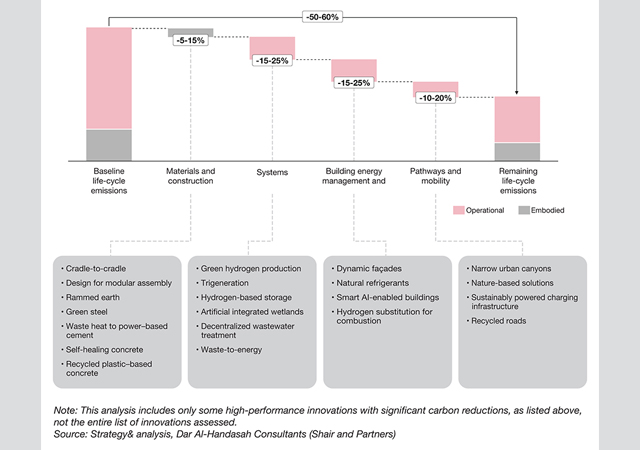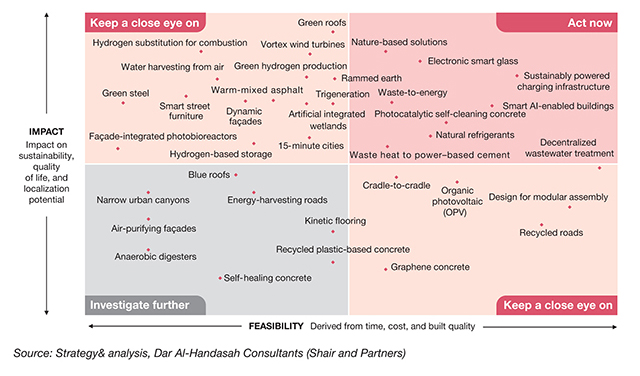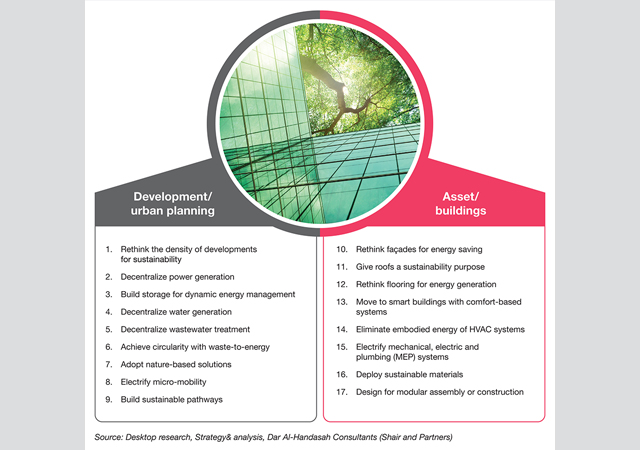$2trn green opportunity
Embracing sustainable practices could help the Middle East’s construction sector to reduce lifecycle emissions by 50 to 60 per cent, says a new report, which recommends that the region should seize the opportunity presented by its construction boom.
01 December 2023
The Middle East, which is currently hosting the 28th Conference of the Parties of the UN Framework Convention on Climate Change (COP28) in the UAE, is intensifying its focus on its net-zero emission targets. In view of this, the region’s $2 trillion construction boom offers it immense potential to become a global leader in sustainable building practices, says a new report.
According to the report by Strategy& Middle East, part of the PwC network, and the planning, design, management and consultancy Dar, embracing sustainable practices could help the region’s construction sector reduce lifecycle emissions by 50 to 60 per cent, potentially taking it halfway to achieving its net-zero emissions goals.
The report, titled “A Sustainable Built Environment: Seizing the Middle East’s US$2 trillion opportunity”, outlines 17 high-potential and actionable applications across multiple areas to reduce emissions, covering more than 50 innovations and technologies. These include areas such as mobility, managed landscapes, development density, mechanical systems, and construction processes.
The report also emphasises the economic benefits of sustainable construction, estimating that it could create 4.3 million jobs per year and contribute more than 10 per cent of the region’s GDP annually.
“The GCC region’s planned scale of investments uniquely positions it to pioneer a range of sustainable technologies and processes. Overall, the built environment is responsible for a high emissions footprint of around 37 per cent of energy use, 39 per cent of CO2 emissions, and 40 per cent of material use globally,” remarked Dr Yahya Anouti, Partner with Strategy& Middle East and the leader of the sustainability platform at PwC Middle East.
“Our estimates show that a reduction in these emissions for urban development could take the region more than halfway to realising its net-zero emissions goals,” he added.
 |
|
Focusing on sustainability innovations in the built environment could reduce emissions by 50 to 60% over the life cycle |
The good news for planners and developers is that some of the technologies and innovations needed to rethink the built environment already exist and can be implemented in the near term, such as solar photovoltaics, greener construction material and artificial intelligence (AI)-enabled systems in buildings.
However, the report indicates that other innovations are nascent and require additional investment and time to develop, test, and integrate.
“If GCC stakeholders – including policymakers, innovators, and developers – embrace a truly innovative and sustainable approach to urban development, they face a golden opportunity to set a new global standard,” remarked Balsam Nehme, Head of Sustainability, Dar Al-Handasah.
“From urban planning to architecture, civil engineering, mechanical systems, and construction materials, sustainable development can deliver better quality of life, incremental economic growth, and develop local skills and jobs,” stated Nehme.
The report points out that the sheer scope of the changes necessary to fully capture the $2 trillion opportunity has significant implications for stakeholders in the built environment.
Regulators would need to play a role in stimulating demand for the technologies, including through the inclusion in green building codes. Developers would need to embrace sustainable construction techniques and may want to set specific goals, such as emission reduction targets.
 |
|
Selected innovations will allow the region to achieve both traditional and new metrics |
Sovereign wealth funds and other financiers are essential to jump-start and drive the transition, potentially by setting net-zero aspirations for the developments they are financing. Collaboration is required among all stakeholders, and their success depends on sharing lessons learned from pilots and trials to drive the adoption of sustainable practices and innovations.
“Our research examines over 50 innovations that can shift the paradigm towards sustainable built environments, substantially reducing emissions from both embodied and operational carbon. These innovations encompass a variety of passive measures, including the design of buildings, as well as active measures, such as more efficient electrical and mechanical systems,” said Sarah Al Feghali, the moonshots and innovation lead of the Ideation Center at Strategy&.
“Additionally, several measures can be implemented to support policymakers in their planning decisions, while aiding developers in addressing the opportunities associated with the region’s built environment aspirations,” she added.
Five notable examples among the 17 ways in which techniques and approaches to the built environment would need to change are:
• Wastewater treatment: Wastewater can be treated on-site, reducing greenhouse gas (GHG) emissions by nearly 90 per cent and decreasing energy consumption;
• Sustainable pathways: Recycled roads and pathways can reduce embodied carbon by more than 90 per cent and can be half as costly as traditional asphalt roads and require less energy for their production;
• Green roofs: These roofs can make building surfaces 30 to 40 per cent cooler and retain stormwater, which is particularly important in the Mena region;
• Modular assembly: Designing for modular assembly can reduce embodied carbon emissions by more than 19 per cent over the lifetime of a building;
• Active facades: These dynamic facades change in response to the surrounding environment, increasing useful daylight and allowing energy savings of up to 55 per cent.
The opportunity is very real; however, seizing it will require dedication and focus across a number of dimensions, including technology investments and upgrading local capabilities, says the report.
The starting point is a fundamental shift in thinking, an acceptance that traditional techniques need to be updated for the net-zero era. The report concludes with some actions that key stakeholders – whether regulators, developers, or sovereign wealth funds – would need to take to make this happen.
The efforts would be considerable and concerted, but the outcome would easily be worthwhile in terms of achieving three key objectives: sustainability, higher quality of life, and localisation, says the Strategy& and Dar report.
- $2trn green opportunity
- GRI scores well with prestigious landmarks
- UAE debut for Volvo CE electric machines



